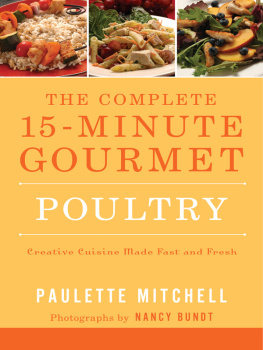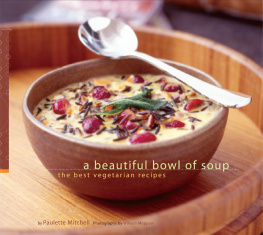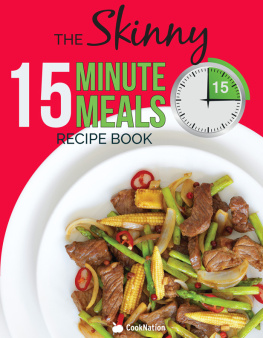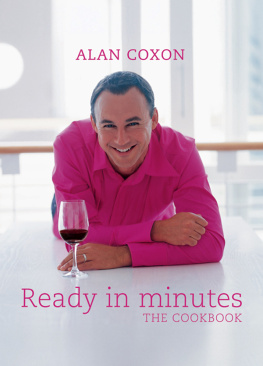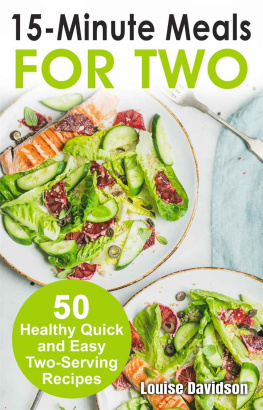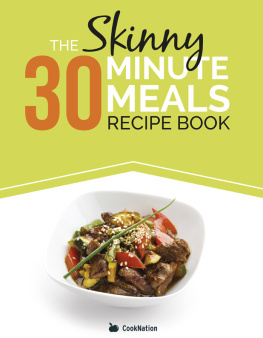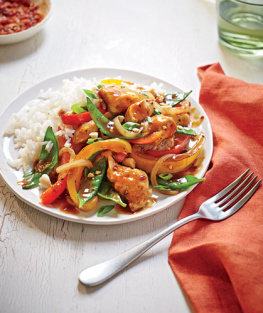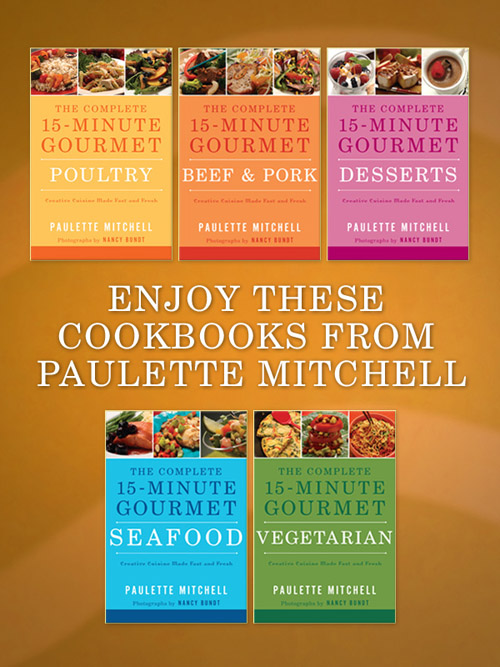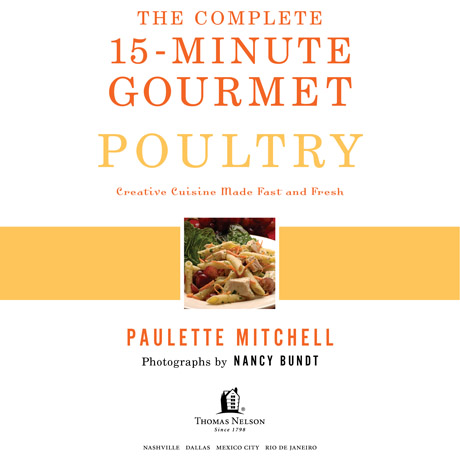
by Paulette Mitchell, 2008
This cookbook is derived from The Complete 15-Minute Gourmet, 2008 by Paulette Mitchell.
All rights reserved. No portion of this book may be reproduced, stored in a retrieval system, or transmitted in any form or by any meanselectronic, mechanical, photocopy, recording, scanning, or otherexcept for brief quotations in critical reviews or articles, without the prior written permission of the publisher.
Published in Nashville, Tennessee, by Thomas Nelson. Thomas Nelson is a trademark of Thomas Nelson, Inc.
Photographs by Nancy Bundt.
Cover design by Kristen Vasgaard.
Page design by Mandi Cofer.
Thomas Nelson, Inc. titles may be purchased in bulk for educational, business, fund-raising, or sales promotional use. For information, please e-mail SpecialMarkets@ThomasNelson.com.
Library of Congress Cataloging-in-Publication Data
ISBN 978-1-4016-0355-7 (hardcover)
ISBN 978-1-4016-0492-9 (ebook)

Contents
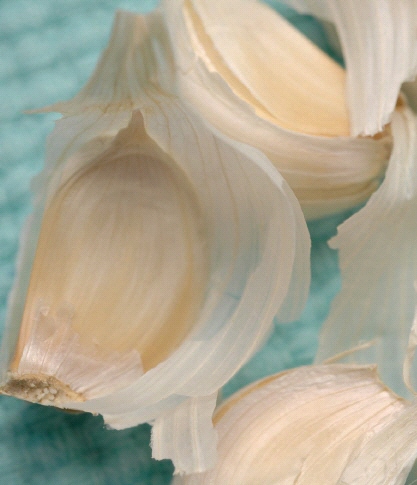
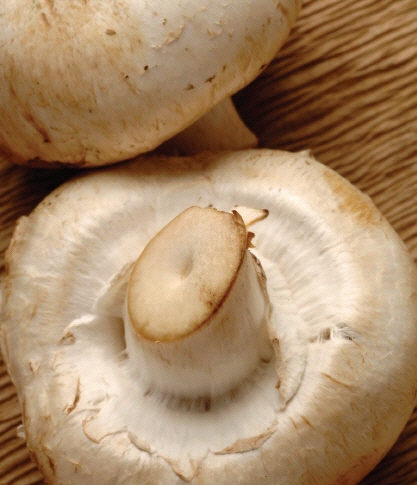
I offer a special thank you to my friends and culinary assistants Cindy Jurgensen and Judy Tills, for their diligence and meticulous attention to detail as they tested recipes; much appreciation also goes to Judy for skillfully styling the photographed recipes. To my dear friend and photographer Nancy Bundt, thank you for sharing your joyful sense of being and artistic talents in the photos that showcase my creations on the pages of this book.
Gratitude also goes to the staff at Lunds, who happily filled specific grocery requests, and the staffs of Cooks of Crocus Hill and Sur La Table, who provided props for the photos.
Many thanks to my son, Brett Mitchell, who enthusiastically consumes my culinary creations, offers his valued opinions, solves my computer woes, and adds infinite joy to my life. My extraordinary, cherished friends and colleagues contributed favorite recipes, tested and tasted mine, and patiently kept in touch during this project; heartfelt thanks go to Arthur Cores, Bret Bannon, Mary Brindley, Stephanie Browner, Shelli Chase, Barbara Cook, Lori English, Conrad and Uni Farinola, Nathan Fong, Carol Frieberg, Mary Hunter, Kristine Igo, Raghavan Iyer, June Jones, Dr. Mumtaz Kazim, Barb Kennedy, Donna Kuehn, Fran Lebahn, Dorothy Long, Leah Mann, Loretta McCarthy, Elisa Lobo Neese, Mary Margaret Ness, An Nguyen, Tom Nugent, Linda Platt, Karen Schmit, Gale and Sue Smieja, Darryl Trones, Ann Ulrich, Claudia Wagner, Carla Waldemar, Judy Witts Francini, and John Yee.
I am grateful to Crescent Dragonwagon, Emeril Lagasse, and Anne Willan, who offered endorsements for this book.
Finally, I offer my sincere appreciation to those responsible for making this book come to be: my agent Jane Dystel, her business partner Miriam Goderich, and the staff at Thomas Nelson, including publishers Pamela Clements and Joel Miller, editor Jennifer Greenstein, Kristen Parrish, Kristen Vasgaard, Mandi Cofer, Scott Harris, Beth Hood, and Jason Jones.
THROUGHOUT CENTURIES, chicken has played a starring role in many of the worlds cuisines. In the late 1990s, I accepted my editors challenge to develop 100 quick-to-prepare chicken recipes. Creating them meant eating lots of chicken, but I discovered that the possibilities are unlimited. Chicken is used in many cuisines, and its mild flavor is compatible with an almost endless variety of herbs and spices, fruits and vegetables. It can be enjoyed hot, at room temperature, or chilled. You can serve chicken with pasta, chicken with rice, chicken with fruit or vegetables, chicken with wine, chicken salads, chicken sandwiches in many forms, and the ultimate comfort food, chicken soup.
The process of disjointing and deboning whole chickens is time-consuming. But boneless, skinless chicken breasts (which are, more accurately, breast halves) are perfect for 15-Minute recipes. If the meat is cut into chunks or strips, it cooks in just five minutes. Whole chicken breasts take five minutes per side when cooked in a skillet, broiler, or stovetop grill pan. Chicken tenders or tenderloins, which are small chicken fillets cut from the most delicate part of the breast, are also used in some recipes. These smaller pieces require less chopping. I do take a minute to snip away the tendon; some chicken producers remove it before packaging. The size of the tenders varies among brands and may alter cooking time. And, of course, many supermarkets offer chicken for stir-fry, which comes completely chopped and ready to use.
One word of warning: Fresh chicken is highly perishable and must be handled and cooked properly. Bring chicken directly home from the market and store it in the coldest part of your refrigerator. If the chicken cannot be used within two days, freeze it. Thaw the frozen chicken in the refrigerator, not on the kitchen counter. Rinse chicken quickly under cool running water and pat it dry before cooking. Be sure to carefully wash all work surfaces that held the raw chicken, as well as your knives and hands. (Clean the cutting board with a sanitizing spray or with a solution of 2 tablespoons chlorine bleach to 1 quart hot water.) I often use poultry shears to cut both raw and cooked chicken. This speedy method eliminates some of the chicken safety concerns because its not necessary for the chicken to touch a cutting board.
Also important is thorough cooking. Properly cooked chicken breasts will be white throughout, with no traces of pink, and the juices will run clear rather than red.
Most of the chicken recipes in this chapter are cooked on the stovetop. In addition to sauting, several recipes are braised. In braising, the chicken is lightly coated with a seasoned flour mixture (for efficiency and less mess, I use a large zip-top plastic bag for chicken in strips). It is then lightly browned, a sauce is stirred in, and the entire mixture simmers until the chicken is thoroughly cooked and tender.
Some recipes call for cooked rotisserie chicken, which is a godsend for days when you are especially pressed for time. Right away when I get home from the supermarket, I remove the skin and pull the chicken from the bone because its most efficient to do this while the meat is warm. Keep in mind that the seasoning added before the chicken is cooked is of little importance; most remains in the skin and does not alter the flavor of the meat. A rotisserie chicken yields about 2 cups white meat and about 1 cups dark meat. I include both in many of my recipes calling for rotisserie chicken. In fact, both light and dark meat are used in some cuisines, and the dark meat actually offers the most flavor. If you prefer, in these recipes you can substitute chicken that you have cooked for the rotisserie chicken. In other recipes, such as , you can use chopped rotisserie chicken rather than cooking chicken yourself.
Here, youll find chicken salads that go miles beyond the tired scenario of cubes of chicken tossed with bits of celery and smothered in mayonnaise. Some of the chicken salads are warm, such as . They are all beautiful and uniquely delicious.

